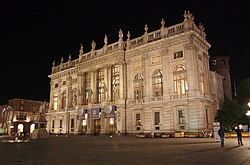Museo Civico d'Arte Antica
Museo Civico di Arte Antica | |
 | |
| Established | 1934 |
|---|---|
| Location | Piazza Castello, Turin, Italy |
| Coordinates | 45°04′16″N 7°41′08″E / 45.071097°N 7.685478°E |
| Type | Art museum |
| Director | Guido Curto |
| Owner | Fondazione Torino Musei |
| Website | website |

The Turin Civic Museum of Ancient Art (Italian: Museo civico d'arte antica) is a museum located in the Palazzo Madama palace, in Turin, Italy.
The museum has a renowned collection of paintings from the medieval, Renaissance and Baroque periods. It reopened in 2006 after several years of restorations.
45°4′15.95″N 7°41′7.72″E / 45.0710972°N 7.6854778°E
History
The museum was founded in 1934, as the heir of the Pinacoteca Regia and the Galleria Reale, which had been established in Palazzo Madama by king Charles Albert of Savoy in 1832.
A Civic Museum had been founded in 1860 in the wake of the unification of Italy although, three years later, the collections were moved to another location in Turin, in Via Gaudenzio Ferrari. These were increased gradually with acquisitions from private collectors, from closed House of Savoy residences or from donations by the same family.
In 1898 the collections of ancient art were separated from modern ones. The former were moved to the current location in 1934 by will of director Vittorio Viale.
Its collection of Asian art, including rare artifacts from Gandhara, coming from the Italian excavations of the IsMEO at the Butkara Stupa in Pakistan, was transferred to Turin's Museum of Oriental Art in 2008.
Description
The museum includes a total of 35 rooms on four floors. The underground floor houses is dedicated to medieval works, the first floor to Gothic and Renaissance painting, the second floor to Baroque works, while the upper floor deals with decorations.

Aside from paintings and sculptures, works exhibited include also illuminated codexes (such as the Turin-Milan Hours), ceramics, porcelains, majolica and ivories (mostly of oriental origin), gold and silver works, as well as a furniture and cloths.
The 15th century Torre dei Tesori ("Tower of the Treasures") is home to several of the museum most known works: Antonello da Messina's Trivulzio Portrait, the Turin-Milan Hours and several objects from Charles Emmanuel I's cabinet. Other works include a series of sculptures of "Dead Christ", paintings by Macrino d'Alba, Giacomo Jaquerio, Giovanni Martino Spanzotti, Defendente Ferrari, Antonio Vivarini, Giulio Campi, Gaudenzio Ferrari, Gandolfino da Roreto, Gerolamo Giovenone, Francesco Hayez, sculptures and goldsmith works from the 8th-13th centuries, Piedmontese coats of arms.
The Camera delle Guardie ("Guards Chambers") houses Baroque paintings by artists such as Orazio Gentileschi (Assumption and St. Jerome), Giovanni Battista Crespi, Giulio Cesare Procaccini and Francesco Cairo.
Sources
- Romano, G. (2006). Palazzo Madama a Torino. Da castello medioevale a museo della città. Turin.
{{cite book}}: CS1 maint: location missing publisher (link)
External links


